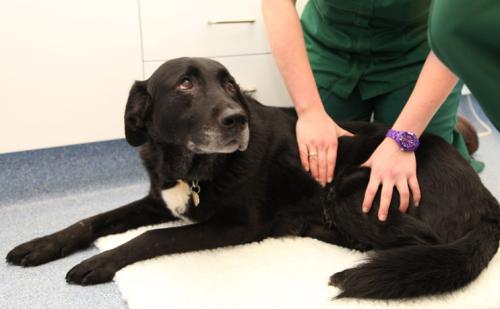Emergencies occur suddenly and without warning, therefore have a basic understanding of the main threats and dangers, and also be able to provide first aid to dogs – important for everyone pet owners. Some emergency situations quite obvious, for example, when a dog ran across the road and hit the car. Other situations can be just as dangerous. but not so obvious. For example, a German shepherd can become restless after a big meal, and will demonstrate vomiting – this may be the beginning of the expansion of the stomach and inversion of the intestines, one of the most dangerous emergencies in large dogs rocks.

Of course, you cannot prepare for all possible threats and dangers, but there are some simple steps you must take follow to clinically identify need in urgent help. Who knows, maybe this will save your life pet.
What to do in an emergency?
Contents
- Keep calm and try not to panic. Rate it situation for any other additional threats to you and your pet. This is important for global security.
- Keep your dog calm and keep his movement to a minimum, especially if she may injure her legs or back.
- Contact the veterinarian and explain to him all the circumstances incidents. Follow all veterinarian instructions.
- For safe transportation of the injured dog, ask someone to help you. A small dog can be put in her carry, but it’s better to remove the lid from it, as you place the dog through a small door can be problematic. In case of large dogs use stretchers made of hard material, for example, from a strong piece of plywood (wood). Cover the dog with a blanket or a towel so she can make light movements. A blanket will also help stabilize the animal’s neck and spine.
How to handle an injured dog?
Most injured animals will be disoriented and, perhaps they will panic. Extreme stress due to extreme situations can make a friendly animal act aggressively. Although most dogs respond well to a soothing voice and stroking the head and shoulders as you approach and when touching an injured animal, it is important to follow precautions.
- Muzzles: you can make a muzzle out of a leash, a belt, rope or pair of tights. Make a loop and lasso around the face, and then tighten it to prevent possible bites. Dogs have only one muscle that opens the mouth, so close its is relatively simple. Dogs can breathe through their nose if it not injured and free.
- Wrap the dog comfortably enough in a blanket to minimize its movement during transportation. Be careful if she may have limb fractures or damage the spine.
- If you suspect a fracture or back injury in your dog, then carefully immobilize it with straps and ropes. Pay particular attention to the immobilization of the neck and head.
What are the most common threats and dangers for dogs?
There are many dangers that can threaten dogs. Below is a list of the most common emergency situations with a description of the main clinical signs and the required first aid. In any emergency situation, it’s important contact your veterinarian as soon as possible to get specific recommendations and instructions.
Anaphylactic shock is severe an allergic reaction characterized by sudden malaise and dangerous breathing problems. First clinical signs anaphylaxis is swelling around the face or muzzle, blisters, or urticaria on the skin, vomiting or diarrhea, anxiety. These clinical symptoms can progress quickly and cause difficulty with breathing. Without timely help, severe anaphylactic shock may end in death. The causes of anaphylactic reactions may be insect bites, food allergies, allergic reactions in result of injection and many others. If you see or suspect your pet may develop anaphylactic reaction, then immediately contact to the vet.
Car Injuries – You Must Make Sure the airways of the dog are completely free. However, be be careful and do not put your hand in your mouth if the dog is conscious. Tax open wounds with clean material. Transport the dog with special care while supporting her body and using a blanket or other Homemade stretchers, if possible. Take it as soon as possible dog at the veterinary clinic.
Bites and injuries from fighting – such injuries and injuries are especially dangerous and require immediate intervention veterinarian if:
- Lots of blood has been lost or if bleeding fails stop.
- The head is affected, especially the eyes, ears, nose and throat.
- There are penetrating wounds in the chest, abdomen, or groin.
Bleeding – it may seem strange for dog owners, but bleeding can be very dangerous and requires immediate veterinary care. Blood may drip a few drops, but it can be so fast that it’s on the floor within a few minutes a whole puddle or bandage forms for it time will become completely wet. Ears, legs, claws, tongue and nose can bleed very much and may require urgent medical attention help to stop blood loss as quickly as possible. When any bleeding you should try to stop it with either using a pressure dressing, or using direct pressure. By however, consult your veterinarian to obtain specific first aid instructions for the dog are still on their way to veterinary clinic.
Bloating, expansion of the stomach and inversion of the intestines – in dogs with bloating or stomach expansion will be observed bulge under the chest with a swollen belly full of gas. Bloating becomes very pronounced and, due to shock, the dog’s condition is rapidly deteriorating. In the initial stages of expansion The dog’s stomach may show unsuccessful attempts at vomiting. it a life-threatening dog situation requires an urgent veterinary help.
Difficulty breathing – If your pet experiencing breathing problems, especially if he breathes through open mouth, you should contact your veterinarian immediately. Be extremely cautious – dogs that have difficulty with breathing, tend to panic and often bite even their owners! Never place fingers in the dog’s mouth with suffocation symptoms.
Burns – May be caused by fire or caustic. substances such as acids and alkalis. These injuries were originally may not be noticed until hair loss occurs or skin change. This is because burns are usually hidden under the dog’s hair. If you saw that your pet was burned or scalded, cool the burn site with running water and cover cold wet towel. If a burn has caused caustic, rinse it with cold running water for 15 minutes to remove any residual substance and soothe the pain. During this time contact your veterinarian and get further instructions.
Cramps and bouts are a series of strong uncontrolled cramping. Most seizures last less than two minutes. If the attack lasts more than five minutes or if you are observing several consecutive seizures, then your dog needs emergency veterinary care to prevent irreversible damage.
During an attack, do not put your hand in your pet’s mouth. Dogs Do not swallow your tongue. Protect your dog from possible injuries, but do not try to interrupt the attack. After the end of the attack, save calm, speak in a soothing voice, stroking or patting the dog. Your dog will need an examination with vet to identify the cause of the seizures.
Diarrhea and vomiting – repeated or continuous vomiting or diarrhea (diarrhea), with or without blood, may be a sign poisoning, gastrointestinal infection or intestinal obstruction. Dehydration is very dangerous, especially for small dogs. Contact your veterinarian if you find a dog in a stool. blood, or if vomiting or diarrhea lasts longer than 6-12 hours, or if your pet is becoming weaker. Bloating abdominal and involuntary futile attempts to vomit often are early symptoms of stomach enlargement and intestinal upset. If you see a dog repeatedly vomiting, don’t wait – contact your veterinarian immediately.
Before using drugs for people, contact and agree this is with the vet. Do not make your pet drink or eat, so you can worsen his condition.
Eclampsia – also known as hypocalcemia. or postpartum tetany. This condition usually occurs in lactating bitches, especially if they have a large litter. In some cases, eclampsia occurs in the later stages of pregnancy. Symptoms of the disease can be implicit and include anxiety, muscle twitches and cramps, cramps, fever and even sudden death. If you think the dog is developing eclampsia, then contact your veterinarian immediately.
Eye injuries – Many eye injuries can result. blindness or loss of the eyeball. Scratch or puncture on corneas are extremely painful. To prevent further damage, do not let the dog rub her eyes. If a blow to the head led to an eyeball falling out of the nest, then keep it moist with saline (e.g. for eye lenses) and protect it from direct exposure. Sudden blindness or loss of vision (your dog may begin to stumble upon objects, and you may notice that her pupils are dilated) may be symptoms of glaucoma. If your dog develops such symptoms like wet eyes, colored discharge from the eye, squinting, sudden dilated pupils, or apparent blindness, immediately seek veterinary care. Thermal blow – can occur in any hot weather. Overheat often happens in cars, in the absence or lack of ventilation. Signs of heat stroke include shortness of breath, lethargy, and unhappy look. Symptoms quickly progress to unconscious state and death. If heat stroke occurs, as soon as possible cool the dog by immersing it in a bath of cold water, if it is small enough, or douse it with a garden hose if it is large. You can also cool the dog with cold wet towels, applying it to her body and legs.
Avoid using ice or ice water as this may lower body temperature too quickly and cause additional complications. Contact your veterinarian immediately and take your dog to the clinic.
Hemorrhagic gastroenteritis is a disease characterized by severe bloody diarrhea (diarrhea) and vomiting. Dog becomes weak and may faint. This condition is quite dangerous and requires urgent veterinary care.
Heart failure – also known as heart attack. Heart failure may not be diagnosed until the dog faints. FROM By the age of the dog, the condition can develop into chronic cardiac failure that can affect either the left half of the heart, either right, or both halves at once. Signs of heart deficiencies include coughing (especially at night), difficulty breathing, discoloration of the tongue (and other mucous membranes), and reduced stamina.
A heart attack is often preceded by heavy exercise or strong excitement. With increased activity, weak heart can’t pump blood fast enough, which leads to lack of oxygen in the muscles and brain. If you observe any of these symptoms, then contact your veterinarian immediately.
Injuries – some injuries require urgent medical care, depending on the type and degree. If you suspect your dog has broken a bone, then immobilize affected area and use a board or other suitable “stretchers” for transporting the animal to the clinic. Any penetrating wound in the chest or abdomen and almost any injury, associated with the eyes, requires emergency veterinary care. Injuries heads and those that cause breathing difficulties should also regarded as emergency situations.
Poisoning of any kind is a situation life-threatening dogs. If you see your dog swallowing suspicious substance, immediately contact your veterinarian. Many different things in the house and garden are potentially poisonous to dogs, including pesticides, chemicals, cleaners and medications. Most poisonings occur without knowledge of the owners.
Clinical signs depend on the type of poisoning, and may include excessive salivation, vomiting, diarrhea, tremors and cramps, skin damage due to caustic substances, etc. If you if there is a label or packaging of a chemical substance, then check first aid instructions, for example, is it necessary induce vomiting. You can induce vomiting with one teaspoon hydrogen peroxide or the same spoon of salt poured into the back the mouth. Save the sample vomit for testing. As quickly as possible seek veterinary care to reduce the effects of the poison. Bring a sample of possible poison to the veterinarian, as well as its packaging. Do not induce vomiting unless specifically agreed with by the veterinarian.
Unconsciousness or fainting – may occur with or without seizures. What happens suddenly for example, in case of acute heart failure or after a stroke on the head. Get veterinary help immediately and get further recommendations and instructions.
What are the symptoms of shock?
Shock is a complex process, accompanied by disruption vital body systems. It can be called big blood loss, heart failure, and other causes circulatory disorders (e.g., heat stroke or anaphylactic shock). Without emergency assistance, shock may cause irreversible damage to body cells, which, in in turn, can be fatal.
Symptoms of shock may include rapid breathing and palpitations, weak pulse (rapid), pale mucous membranes (lips, gums, eyelids), severe depression, lethargy, cold limbs and ears. Dog can vomit. Shock requires immediate medical attention. help.
And in conclusion, it is worth noting that after an accident or threatening pet life situation, it is important that you seek veterinary help as quickly as possible, even if it seems to you that it is completely is healthy.






